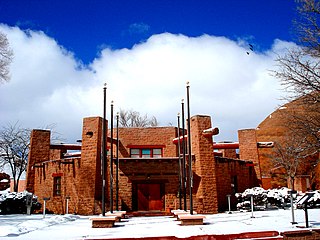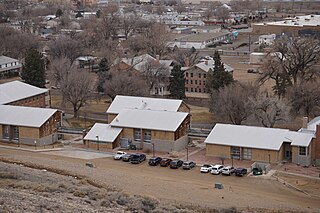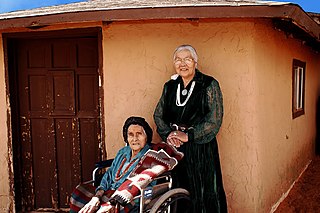
Ganado is a chapter of the Navajo Nation and census-designated place (CDP) in Apache County, Arizona, United States. The population was 1,210 at the 2010 census.

Window Rock is a census-designated place that serves as the seat of government and capital of the Navajo Nation, the largest territory in North America of a sovereign Native American nation. The capital lies within the boundaries of the St. Michaels Chapter, adjacent to the Arizona and New Mexico state line. Window Rock is the site of the Navajo Nation governmental campus, which contains the Navajo Nation Council, Navajo Nation Supreme Court, the offices of the Navajo Nation President and Vice President, and many Navajo government buildings.
Trinity Washington University is a private university in Washington, D.C. affiliated with the Catholic Church. Trinity is a comprehensive university with five schools; the undergraduate College of Arts & Sciences maintains its original mission as a liberal arts women's college, while men attend Trinity's other schools at both the graduate and undergraduate level. The university was founded as Trinity College by the Sisters of Notre Dame de Namur in 1897 as the nation's first Catholic liberal arts college for women. Trinity was chartered by an Act of Congress on August 20, 1897. Trinity became Trinity Washington University in 2004.

Diné College is a public tribal land-grant college in Tsaile, Arizona, serving the 27,000-square-mile (70,000 km2) Navajo Nation. It offers associate degrees, bachelor's degrees, and certificates.

Hampton University is a private, historically Black, research university in Hampton, Virginia. Founded in 1868 as Hampton Agricultural and Industrial School, it was established by Black and White leaders of the American Missionary Association after the American Civil War to provide education to freedmen. The campus houses the Hampton University Museum, which is the oldest museum of the African diaspora in the United States and the oldest museum in the commonwealth of Virginia.First led by former Union General Samuel Chapman Armstrong, Hampton University's main campus is located on 314 acres in Hampton, Virginia, on the banks of the Hampton River. The university offers 90 programs, including 50 bachelor's degree programs, 25 master's degree programs and nine doctoral programs. The university has a satellite campus in Virginia Beach and also has online offerings. Hampton University is home to 16 research centers, including the Hampton University Proton Therapy Institute, the largest free-standing facility of its kind in the world. Hampton University is classified among "R2: Doctoral Universities – High research activity."

Hubbell Trading Post National Historic Site is a historic site on Highway 191, north of Chambers, with an exhibit center in Ganado, Arizona. It is considered a meeting ground of two cultures between the Navajo and the settlers who came to the area to trade.

The Central Philippine University is a private research university in Iloilo City, Philippines. Established in 1905 through a benevolent grant of the American industrialist and philanthropist, John D. Rockefeller, as the Jaro Industrial School and Bible School under the auspices of the American Baptist Foreign Mission Society, it is the first Baptist founded and second American and Protestant university in the Philippines and in Asia. In 1913, women were first admitted to the school and it was later converted into a junior college in 1923 as Central Philippine School and as Central Philippine College in 1924. In 1953, the college attained university status.

Don Lorenzo Hubbell was a 19th-century trader instrumental in promoting the sale of Navajo art. He was also sheriff of Apache County, Arizona, a member of the Arizona Territorial Legislature, and after statehood a member of the Arizona Senate. He ran unsuccessfully for the United States Senate in 1914.

The United States (U.S.) Cadet Nurse Corps (CNC) was authorized by the U.S. Congress on 15 June 1943 and signed into law by president Franklin D. Roosevelt on 1 July. The purpose of the law was to help alleviate the nursing shortage that existed before and during World War II. The legislative act contained a specific provision that prohibited discrimination based upon race, color, or creed. The United States Public Health Service (USPHS) was named the supervisory agency; it was answerable to Thomas Parran, Jr. the surgeon general of the United States. The USPHS established a separate division to administer the CNC program and Parran appointed Lucile Petry a registered nurse (RN) as its director.
The University of Sioux Falls (USF) is a private Christian university in Sioux Falls, South Dakota. The university was founded in 1883. In fall 2014, the university enrolled a total of 1,142 undergraduate students and 311 graduate students.

Bacone College, formerly Bacone Indian University, is a tribal college in Muskogee, Oklahoma. Founded in 1880 as the Indian University by missionary Almon C. Bacone, it was originally affiliated with the mission arm of what is now American Baptist Churches USA. Renamed as Bacone College in the early 20th century, it is the oldest continuously operated institution of higher education in Oklahoma. The liberal arts college has had strong historic ties to several tribal nations, including the Muscogee and Cherokee. The Bacone College Historic District is listed on the National Register of Historic Places.

Navajo Preparatory School is a college preparatory school located in Farmington, New Mexico. The school is fully sanctioned by the Navajo Nation since 1991 when the previous Navajo Academy closed due to lack of funding. The campus is currently undergoing a remodelling project for the past few years that includes new dormitories, classrooms, and an athletic sports complex. The school colors are black, turquoise, yellow, and white which represent the four seasons in Navajo Culture and the mascot is the eagle. The previous school colors for Navajo Mission and Navajo Academy were red, white, and blue. In 2021- 2022 school year, the school color will go back to red, white, and blue.

The Iloilo Mission Hospital, commonly referred to as Mission Hospital, Mission, CPU–IMH or IMH, is a private tertiary, academic and teaching hospital located in Jaro, Iloilo City, Philippines. Established in 1901 through the auspices of the Presbyterian Foreign Mission Board from the United States by the American missionary doctor, Joseph Andrew Hall, it is the "first and oldest American and Protestant founded hospital in the Philippines". It was originally named as Sabine Haines Memorial Union Mission Hospital in memory of Charles Haines's son, a New Yorker whose grant made possible for the founding of the hospital.

The Bureau of Indian Education (BIE), headquartered in the Main Interior Building in Washington, D.C., and formerly known as the Office of Indian Education Programs (OIEP), is a division of the U.S. Department of the Interior under the Assistant Secretary for Indian Affairs. It is responsible for the line direction and management of all BIE education functions, including the formation of policies and procedures, the supervision of all program activities, and the approval of the expenditure of funds appropriated for BIE education functions.

The Phoenix Indian School, or Phoenix Indian High School in its later years, was a Bureau of Indian Affairs-operated school in Encanto Village, in the heart of Phoenix, Arizona. It served lower grades also from 1891 to 1935, and then served as a high school thereafter. It opened in 1891 and closed in 1990 at the orders of the federal government. During its existence, it was the only non-reservation BIA school in Arizona.

The Central Philippine University College of Nursing, also referred to as CPU CON, CPU College of Nursing, CPU Nursing, is one of the academic units of Central Philippine University, a private university in Iloilo City, Philippines. Founded in 1906 as Union Mission Hospital Training School for Nurses, it is the First Nursing School in the Philippines.
Elaine Elizabeth Abraham was a Tlingit elder and registered nurse who contributed to improving health care delivery in rural Alaska. Later active professionally in the field of education, she assisted with the creation of the Alaska Native Language Center, and, as a statewide administrator at the University of Alaska, in 1976, led the establishment of community colleges in underserved parts of the state.

Grace Henderson Nez was a Navajo weaver, known for her traditional designs. Her main styles were old designs from the 19th century and Ganado style. Some of her work was demonstrated at the Hubbell Trading Post, which is home to an archive of works from various Navajo weavers. Before her death in 2006, she was able to win two lifetime achievement awards for her work, including a National Heritage Fellowship from the National Endowment for the Arts.
Claudeen Bates Arthur was a Native American lawyer who was the first Navajo woman licensed as a lawyer in the United States and the first female Chief Justice of the Supreme Court of the Navajo Nation.
Martha Blue is an American lawyer and author. She is a partner in the Arizona law firm of Wade and Blue.

















